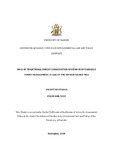| dc.description.abstract | Kenya continues to lose its forests despite developing relevant policies, legal mechanisms and institutions to curb this trend. Traditional Forest Conservation Systems (TFCs) are another alternative to conserve forests; these systems have been successful in sustainably managing different types of forests. However, there is intra-generational loss and none use of these systems of knowledge. This study therefore investigated how best we can meet the changing needs of the current and future generations without losing the benefits that Traditional Forest Conservation Systems have yielded over time. Specifically, it (i) examined the provisioning, regulating, cultural and support services provided by the forest to neighbouring communities; (ii) assessed how Kipsigis traditional forest conservation practices have affected provision of these services; and (iii) assessed how good practices from traditional forest conservation systems could be integrated into conventional forest conservation systems at county level. The study was cross-sectional and it utilized mixed methods of research. Respondents included 151 randomly selected households, 9 key informants and three Focus Group Discussions made up of 8 people drawn from the council of elders, women groups and youth groups. Key informants included, the Kenya Forest Service, National Museums of Kenya, Kenya Forestry Research Institute, the County Executive Committees on Water, Environment and Natural Resources; and Trade, Cooperative and Wildlife of Kericho County. The study found that first, the hill was still important to communities that live adjacent to it because they accrue a number of cultural, provisioning, regulating and support services from it. Secondly, that the TFCS activities directly depend on conservation of indigenous tress; loss of indigenous trees therefore equals loss of TFCS in Kericho County. Thirdly, Good practice analysis shows that the withdrawal of traditional leaders from forest management coincided with changes in forest cover, structure and land use; thereby leading to deforestation and forest degradation as exemplified by the Kaya and Loita Forests and Kipsigis Sacred Hill. The study inferred therefore that TFCS are important in sustainable forest management. It recommends that good practices in TFCS should be assimilated in forest policies at county levels for sustained management of both exotic and indigenous forests. Moreover, these systems should be incorporated in contemporary systems of education; in this case, the council of elders should be involved in teaching this type of knowledge at schools- right from primary to tertiary level to prevent loss of this knowledge. | en_US |



